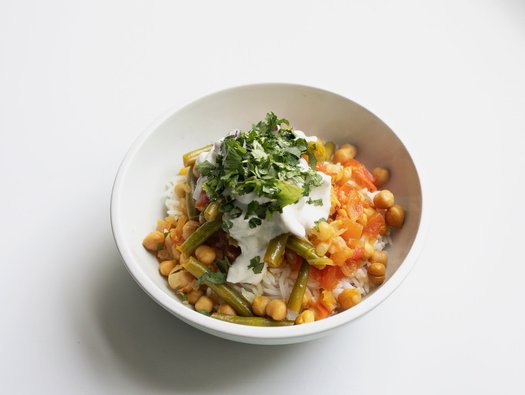Chickpea curry

A hearty vegan curry which is low in potassium, salt and phosphate.

A hearty vegan curry which is low in potassium, salt and phosphate.
2 tablespoons olive oil
2 large red onions, thinly sliced
2 cloves garlic, crushed
15g fresh ginger root, peeled and thinly sliced
1 teaspoon turmeric
2 teaspoons garam masala
2 400g tins of chickpeas, drained and rinsed
200g green beans
4 medium tomatoes, chopped
1 lemon, zest and juice
320g basmati rice, rinsed
Small handful of coriander, chopped
200g plain yoghurt
Heat the oil in a large frying pan and add 1½ red onions, keeping the remaining onion on the side for later. Fry for 6 minutes until softened
Add garlic and ginger to the pan and cook for 2 minutes and then add turmeric and garam masala. Stir through and simmer for a couple more minutes.
Add in chickpeas, green beans and 600ml of water, stir well to combine and then bring to the boil and simmer for 15 minutes.
To cook rice, put into a pan with double the amount of water, bring to the boil, put a lid on pan and turn heat down, cook for 10 minutes.
Add the chopped tomatoes to the curry, mix well and continue to simmer for another 10 minutes. Mix the remaining sliced onion with the lemon zest and yoghurt. Once the curry is cooked, add the lemon juice and give a final stir, then remove from heat.
Serve the curry on top of the rice, with a spoonful of yoghurt mix topped with coriander.
The rice is the main source of carbohydrate in this main meal, although the chickpeas will also contribute to the carbohydrate content. The value has been provided for those who have been trained in insulin adjustment.
This dish is low in potassium, despite the use of some high potassium ingredients. This is because the quantities per person have been carefully measured. If you have been advised to follow a low potassium diet, ensure you keep to the quantities stated.
This recipe is low in phosphate, but does contain some phosphate, therefore, if you have been prescribed a phosphate binder ensure you take them with this dish.
This dish is high in protein and therefore suitable for those receiving dialysis.
Use a cheaper vegetable cooking oil such as vegetable or sunflower oil and consider omitting the fresh chopped herbs to reduce the cost.
Replace the yoghurt with soya yoghurt.
By giving us your email address, you're giving us permission to send you the latest news from Kidney Care UK. Further information about how we protect and use your personal data is available in our Privacy policy. If you would like to change the way we communicate with you at any time please email [email protected]. You can unsubscribe at any time by using the link at the bottom of every email we send.